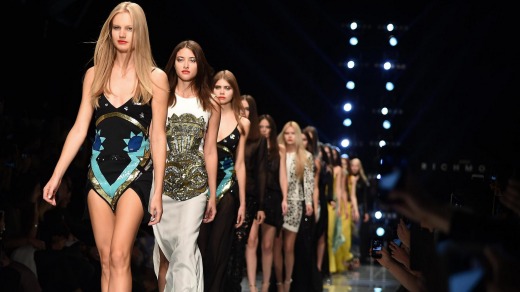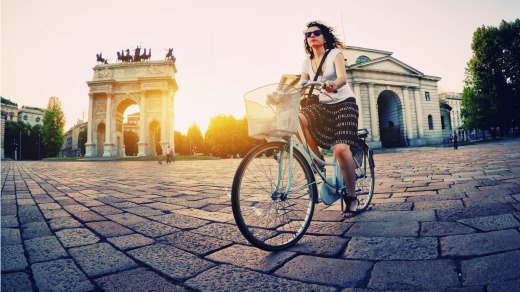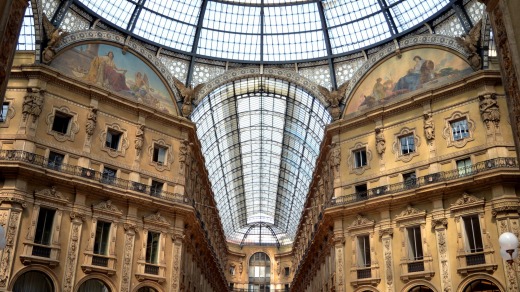Off the train at Milan Central station, I went straight to the kiosk selling Milan citycards (free public transport, museum discounts etc). They are supplied gratis to journalists arriving for Expo 2015 - in return for a 30-second video plug. "Just say how much you appreciate the MilanoCard," said the young lady in the shortest skirt I've seen since 1974. "But I've only been here three minutes." "Say it anyway," she said. So I did. She filmed. The result apparently lurks in the darker recesses of YouTube. Tragically, I lost the card almost at once, so cannot tell you if it is as useful as I claimed. Probably.
Expo 2015 opens this week. Its aim is to feed the planet, cause deserts to bloom and introduce us to the cuisine of Vanuatu, among very much else. A subsidiary impulse is to attract more visitors to Milan itself. After my trip, I'd say this can't fail.
As you may know already, Milan is smart and serious, with clear city-state aspirations. Milanese people I met evidently considered the rest of Italy a slight embarrassment. Here is the capital of finance, of media, of soccer and, Lord help me, of fashion. You can hear the snap of the creases in the average Milan outfit. Fortunately, I'd just acquired cool new spectacles and 21st-century shoes. As long as no one noticed the bits in between, I'd be fine.

I glided around like a native, albeit one who had never before visited the city. And, crikey, what a monumental sense of entitlement Milan has. In the Piazza del Duomo, a manifest destiny to run things smacks you in the face. There's Victor Emmanuel II reining his horse in, lest he trample amblers of all nations. They're mainly looking at the cathedral which, newly cleaned, appears white but encompasses gradations of pink and grey.
The facade might well tip you over the edge, were you hovering on the brink of belief. It's beyond magnificent. Granted, it took 500 years to complete - slow, even by the standards of the Italian building industry - but, well, imagine creating that extraordinary forest of spires and pinnacles and then saying: "What they all need now is a statue on top". Faith, architecture and power made fine allies back then. Shortly, I went inside and got furious, so would like to warn tourists everywhere that they have 48 hours to dispose of their selfie-sticks. After that, I'll be tackling the devices with an axe. Thus, will I no longer have to tolerate single-cell French adolescents throwing the shaka sign to picture themselves before St Bartholomew Flayed. Or anyone else doing the same thing anywhere else, ever. Two days, and that's it.
Nearby, the triumphal entry to the Victor Emmanuel arcade was covered in scaffolding. Milan was sprucing itself up for Expo. But the arcade still resembled more a place you'd hold a peace conference than a shopping trip. Tragic, then, that it should be colonised by Prada, Louis Vuitton and all the others established wherever big money congregates. How do rich people know where they are, when they find exactly the same shops everywhere?

With that, I swished to the fashion district and, directly upon entering the pedestrianised Via della Spiga, fell upon the most vibrantly purple suit I've encountered since Blackpool in 1974. (That's where I also saw the skirt.) Like all the men's clothes around here, though, the trousers appeared too short on the mannequin, and the jacket too tight. This was a trend I pioneered myself decades ago, when I was dressed by the Oxfam shop, which never had anything big enough. But clothes soon get boring. I was more taken with the security men, standing guard with gravitas at, say, Tod's. I was on the very point of flinging open the door to cry: "Lighten up, lads, you're only selling shoes," when my eye was caught by Dolce & Gabbana. Its storefront is the length of a soccer pitch. I moved directly across and then immediately away, respecting Sir Elton's boycott. The squads of Oriental and Middle Eastern ladies sadly failed to follow suit.
In stately home surroundings, the Brera art gallery had all the yearning, beseeching and adoring rife in 16th and 17th-century Italian art. (You'd think the Christian offer was pretty grim from looking at the pictures.) Some cracking works, though - not least Caravaggio's 1606 version of Supper at Emmaus, and Rubens's Last Supper, which looks like a bunch of workmates down the pub. Not far away, the Castello Sforzesco indicated that Milan had long felt itself authoritative. The Viscontis were dukes, then the Sforzas, everyone adding bits to the castello until it was the size of a hamlet, and looked fit to hold all Europe at bay. Odd, then, that the city kept getting taken over by Spaniards, French and Austrians.
Clearly, there were reasons for this. I'll dig them out some time. Right then, though, I was due for dinner on a roof terrace with Milanese friends. I ditched studious intentions for an asparagus lasagne, a bottle of Brunello di Montalcino and stirring company. Next morning, MilanoCard lost and bus to hand, I jumped on ticketless. "Just what Milan needs," said a companion later. "Another delinquent grandfather".

The Navigli district is where Milan goes mildly bohemian, with canal-side bars, restaurants and perhaps the only shop in continental Europe where one can buy an Essex policeman's cap. Here, if a fellow's trousers are too short, it's because they are too short, not because he's in the vibe. Navigli is the funky flip side every great city needs. It's also quite near the church of Sant Ambrogio, about which I would tell you more, except that the moment I got in, the doors shut for a funeral. Within moments, the coffin was walked up the aisle. Ten minutes in, I felt I could leave. "I only knew him slightly," I explained to the chap on the door. He nodded sympathetically, and I made haste to Santa Maria delle Grazie, where I had a 15-minute slot at 13.30. Fifteen minutes is all you get before Leonardo's Last Supper. And, as for Eton, you need to have reserved a place at birth.
Astonishingly, I had the 13.30 slot to myself. This was fabulous. You need to maximise your allotted minutes. Initially, the fresco looks like a ghost of a picture, such has been the effect of time. But then you walk to the middle of the refectory (The Last Supper is a monastery dining room decoration), you stop and you walk back towards the painting. And - here's the thing - you know that, if there weren't a railing there, you could walk right into the picture, sit down and start talking to the apostles. There are many fine and extraordinary things in Milan but this is the most extraordinary of all.
The Telegraph, London